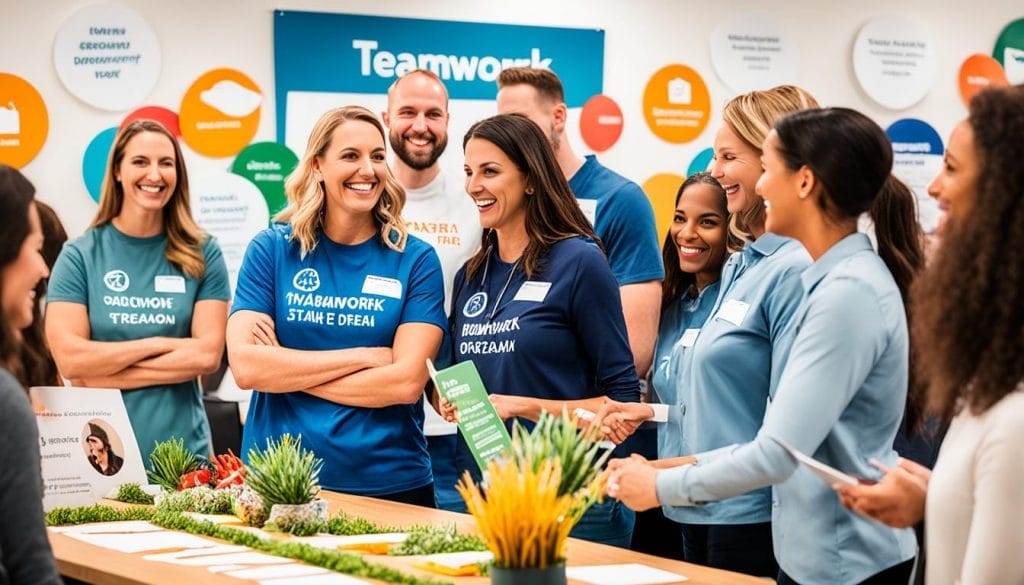Did you know companies with good onboarding see a 50% jump in new hire productivity? This shows how key rapid onboarding is for seasonal workers. As businesses prepare for busy seasons, training seasonal hires efficiently is crucial.
Onboarding seasonal workers right is key to making them productive fast. A strong onboarding process for temps not only raises productivity. It also makes employees happier and more likely to stay. Let’s look at five effective ways to improve your seasonal hiring.
Key Takeaways
- Effective onboarding increases new hire productivity by 50%
- Well-structured processes enhance employee satisfaction and retention
- Rapid onboarding is crucial for seasonal business success
- Tailored techniques can significantly improve temporary worker performance
- Efficient onboarding leads to reduced turnover and increased engagement
Understanding the Importance of Effective Seasonal Onboarding
For tree care businesses, effective seasonal onboarding is key. It helps set the stage for success. It also affects how well employees do their jobs and how long they stay. Let’s see why it’s so important to have good orientation programs for contract workers.
The impact on employee performance and retention
Seasonal workers who get good onboarding are more likely to come back. This means higher retention rates. They also become happier and more motivated, which makes customers happier too. This is super important in tree care, where customers matter a lot.
Cost-saving benefits of streamlined onboarding
Onboarding that’s easy to follow cuts down on training time and paperwork. This saves tree care companies a lot of money. Money saved on long training can be used to make more money.
| Benefit | Impact |
|---|---|
| Reduced training time | Accelerated production, improved operational smoothness |
| Enhanced worker proficiency | Improved output quality, positive customer experience |
| Increased safety awareness | Fewer accidents, reduced operational interruptions |
Creating a positive first impression for seasonal workers
Making a good first impression makes seasonal workers feel important right away. This shapes their whole job experience. Giving them a full orientation teaches them about the company’s rules and values. Training them on key skills helps them do well during their short time there.
By focusing on good onboarding, tree care businesses can support their seasonal workers. This helps keep them around longer and makes the company do better during busy times.
Pre-boarding: Setting the Stage for Success
Pre-boarding starts before the official start date. It’s key for talking well with temporary staff and making a good first impression. This phase prepares everyone for a great work experience.
Sending important papers and details about dress codes and parking makes new hires feel ready. Regular check-ins help ease nerves and get them excited to join the team.
Studies show that pre-boarding really helps keep employees:
- 37% more people show up for work with pre-boarding
- 95% of workers stay with the company if they feel connected
- Up to 20% of new hires leave within 45 days without good onboarding
Managers should welcome new hires and explain the onboarding process. They should also set clear expectations for the first day. This makes new workers feel like they belong and helps them do well.
“Pre-boarding is the first step in creating a positive lasting impression on seasonal workers, making them feel valued from day one.”
| Pre-boarding Activity | Purpose | Impact |
|---|---|---|
| Welcome emails/videos | Create excitement | Increased engagement |
| Paperwork completion | Streamline processes | Smoother first day |
| Logistical information | Reduce anxiety | Better preparedness |
| Team introductions | Foster connections | Improved integration |
Structured Onboarding Programs for Seasonal Employees
Starting with a good onboarding program is key to managing seasonal employees well. These programs help new hires fit in fast with their jobs and the company’s culture.
Designing Comprehensive Orientation Sessions
Orientation sessions are the heart of onboarding for seasonal workers. They teach new people about the company’s rules, how things work, and what the company values. Doing this right can save money, as it costs about $11,000 to fill a job.
Implementing Role-Specific Training Modules
Training modules that fit the job are important for seasonal workers. They need to learn the skills for their job quickly, as they often have less than a week to catch up with regular staff.
- Use video presentations with handbooks to improve retention rates by 83%
- Invest in the same training content for seasonal and full-time employees
- Focus on making more and reducing mistakes during busy times
Facilitating Introductions to Key Team Members
It’s important for seasonal workers to make friends fast. Meeting the important people at work makes them feel part of the team and more engaged. Happy employees are much less likely to leave, which is good for keeping them around.
| Onboarding Element | Impact |
|---|---|
| Structured Program | 54% increase in new hire productivity |
| Comprehensive Training | 83% improvement in retention rates |
| Team Integration | 87% decrease in turnover likelihood |
Using these onboarding methods can really help seasonal workers do better and make the workforce more effective.
Leveraging Digital Solutions for Efficient Onboarding
Digital tools change how we onboard seasonal workers. They make training more efficient and fun. E-learning, digital documents, and VR help new hires start fast.
E-learning Platforms: A Game-Changer
Platforms like LinkedIn Learning and Coursera offer fun training for seasonal workers. They help workers remember more and do better on the job. A study showed that good onboarding led to more sales and happier customers.
Digital Document Management
Tools like BambooHR and Workday make documents easy to find and cut down on paperwork. This is key for onboarding seasonal workers, especially in places like restaurants where rules are strict.
Virtual Reality: Immersive Onboarding Experiences
VR gives new hires a deep dive into complex tasks. This new way of training helps workers stay with the job longer and creates a happy work place.
| Digital Solution | Benefits | Impact on Seasonal Onboarding |
|---|---|---|
| E-learning Platforms | Interactive training, increased retention | 60% revenue increase, 63% customer satisfaction boost |
| Digital Document Management | Simplified access, reduced paperwork | Fewer compliance issues, streamlined processes |
| Virtual Reality | Immersive experiences, better understanding | Improved retention rates, positive work atmosphere |
Using these digital tools, companies can make onboarding seasonal workers better and more fun. This way, new hires are ready and fit in fast, helping the business do well during busy times.
Seasonal Employee Onboarding Techniques
For companies that hire seasonal workers, having a good onboarding process is key. It helps set these employees up for success and boosts productivity during busy times.
Personalizing the onboarding for each worker is important. It makes them feel important and understood. This can make them happier and work better.
Good communication is also key. Seasonal workers need to know about:
- Job responsibilities
- Company policies
- Performance expectations
- Workplace safety measures
Sharing this info early helps them do well and lowers the chance of getting hurt. Workers with less than a year on the job are five times more likely to get hurt.
Using a buddy system can make onboarding better. It pairs new workers with those who know the ropes. This gives support and helps them feel part of the team.
Using digital tools can also make onboarding easier. Things like online learning, short videos, and easy-to-find resources help workers learn fast and well.
“Equipping workers with the proper tools is essential to their success and satisfaction.”
By using these methods, companies can make a great place for their seasonal workers. This leads to smooth operations during the busy times.
Personalized Onboarding Experiences for Seasonal Hires

It’s key to make onboarding for seasonal workers special. This helps keep them engaged and boosts their work speed. By making the process personal, companies can welcome new hires smoothly and make them work better.
Tailoring Onboarding Content
Custom onboarding content fits each worker’s role and background. This is super useful in retail, where lots of new staff are needed during holidays.
Customized Resources and Materials
Role-specific resources give seasonal workers what they need to do well. For example, in hotels, training might focus on talking to customers and solving problems. This helps with the special challenges of the job.
Flexible Learning Paths
Flexible learning fits the different skills of seasonal workers. This is great for the gig economy, where workers might be students or seniors.
| Onboarding Element | Benefit | Example |
|---|---|---|
| Role-specific training modules | Faster skill absorption | Technical job training for manufacturing roles |
| Multilingual support | Inclusive learning environment | Training materials in multiple languages for diverse teams |
| Regular check-ins | Continuous improvement | Weekly feedback sessions with supervisors |
Using these personalized onboarding methods makes the job experience better for seasonal staff. This leads to better work and more people staying with the company.
Continuous Feedback and Check-ins During the Onboarding Process
Regular feedback and check-ins are key for managing seasonal employees well. A structured communication approach helps ensure effective talks with temporary staff during their time with us.
Managers who often talk with their team see a big jump in team spirit. This leads to better work results, making places 21% more profitable. To get the most out of this, try these tips:
- Create a first-day checklist to prepare new hires for their initial week
- Assign an onboarding buddy to help seasonal workers acclimate quickly
- Develop standard operating procedures (SOPs) for easy reference
- Organize module-based training sessions to encourage employee progress
Recognizing hard work is a big motivator. Research shows 69% of workers do more when they feel noticed. Regular feedback helps spot and fix problems early, making a supportive place for seasonal staff.
“Continuous feedback during onboarding ensures seasonal employees feel valued and supported, leading to increased productivity and better customer service.”
Using employee onboarding software can make giving feedback easier. These cloud tools are great for all kinds of businesses, making training consistent across different places.
| Benefits of Continuous Feedback | Impact on Seasonal Workforce |
|---|---|
| Increased engagement | 3x more engaged employees |
| Improved productivity | 21% increase in profitability |
| Enhanced retention | Lower turnover rates |
| Better customer service | Improved customer satisfaction |
By focusing on ongoing feedback and using tech, companies can make onboarding great for seasonal workers. This helps them do well from the start.
Fostering a Supportive Culture for Seasonal Workers

Making a warm welcome is crucial for keeping seasonal workers and boosting output. Companies that focus on seasonal workers see a 25% jump in commitment. Let’s look at ways to build a positive work culture for temporary staff.
Buddy Systems and Mentorship Programs
Linking new seasonal workers with seasoned staff gives them support and advice. This method makes new hires feel part of the team and valued, raising productivity by 15%. Mentors share the company’s culture, answer questions, and help new workers do their jobs better.
Team-Building Activities for Integration
Planning team events helps build good relationships among all staff. Events can be group lunches, outdoor fun, or online games for remote teams. Such activities boost teamwork and talking, key for smooth work during busy times.
Recognizing Seasonal Employees’ Contributions
Thanking seasonal staff for their hard work lifts their spirits and job satisfaction. Think about starting a rewards plan or giving bonuses or extra paid time off. This thanks can make seasonal workers 20% more committed, helping the team do better and stay together longer.
“Seasonal employees who feel valued and supported are more likely to return for future seasons, reducing recruitment and training costs.”
Using these methods, companies can build a caring culture that helps both seasonal workers and the business. This way, keeping seasonal workers helps with long-term success and growth.
Conclusion
For businesses with changing needs, having good onboarding for seasonal workers is key. Using structured programs and digital tools helps new hires fit in fast. Adjusting to seasonal shifts with tailored onboarding leads to keeping workers longer and better performance.
Onboarding should make new workers feel supported. This can cut turnover by half and increase productivity by more than 70%. Activities like buddy systems, team-building, and regular feedback make seasonal workers feel important and part of the team.
Today’s fast business world means using tech for onboarding is important. Tools like e-learning, digital document systems, and virtual reality make the process smoother. These tools save time and money and help seasonal workers learn in ways that work for them.
A good onboarding plan for seasonal workers is a smart move for your business. It makes work better, boosts engagement, and can lead to lasting relationships with great seasonal workers.
FAQ
Q: Why is effective onboarding crucial for seasonal hires?
A: Effective onboarding is key for seasonal hires. It helps new employees fit in and do well. It makes them feel part of the team and work faster.
It also keeps them happy and working well, which helps the company too.
Q: What are the benefits of effective seasonal employee onboarding?
A: Good onboarding makes seasonal workers happier and more skilled. It cuts down on leaving and saves money by easing paperwork. It also makes a great first impression, making new hires feel important and connected.
Q: What activities are involved in pre-boarding for seasonal hires?
A: Pre-boarding starts before the new hire’s first day. It includes sending important papers and details on dress codes and parking. Keeping in touch with new hires reduces stress and builds excitement for joining.
Q: What should structured onboarding programs for seasonal employees include?
A: Onboarding programs should have detailed orientation, training for the job, and meeting the team. Orientation teaches about company rules and values. Training makes sure new hires know what they need to do.
Q: How can digital solutions enhance the onboarding experience for seasonal hires?
A: Digital tools like online learning, managing documents online, and virtual reality make onboarding better. Online learning is easy and flexible. Managing documents online cuts down on paperwork. Virtual reality makes learning more real and helps people remember more.
Q: What are some effective seasonal employee onboarding techniques?
A: Good ways to onboard seasonal workers include making it personal, clear communication, and giving them what they need. Making it fit their role and job, explaining what’s expected, and giving them training and access to systems helps them get started fast.
Q: How can personalized onboarding experiences benefit seasonal hires?
A: Personalized onboarding means making it fit the worker’s role and background. It gives training specific to their job and the resources they need. This makes them feel like they belong, helps them fit in faster, and keeps them more engaged.
Q: Why are regular feedback and check-ins important during the seasonal onboarding process?
A: Feedback and check-ins are key during onboarding. They help spot and fix problems early, keep communication open, and give support when needed. They also help make the onboarding better and keep seasonal workers feeling supported and valued.
Q: How can organizations create a supportive culture for seasonal workers?
A: To support seasonal workers, use buddy systems or mentorship, team activities, and celebrate their work. Buddies offer help and connection. Team activities bring everyone together and make positive relationships. Celebrating their work boosts their motivation and happiness.





